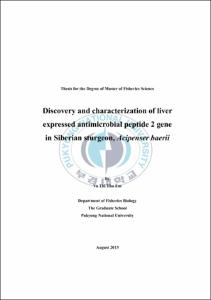Discovery and characterization of liver expressed antimicrobial peptide 2 gene in Siberian sturgeon, Acipenser baerii
- Abstract
- Siberian sturgeon, is one the most important economic species of the fresh water in the world, especially Caviar. However, there is little information about innate immune functions against microbial pathogens that were studied in sturgeon. Liver-expressed antimicrobial peptide 2 (LEAP-2) gene is one of antimicrobial peptide that has an important role in innate immune system of sturgeon. There are 3 goals to obtain in this study. The first is to isolate and characterize the structure of LEAP-2 gene from Siberian sturgeon. The second is to examine the basal and induced expression. The third is to characterize the functions under challenges with many species of bacteria. The results showed that, LEAP-2 cDNA and polypeptide are predicted to exhibit a similar structure with vertebrate orthologues. However, the matured peptide of LEAP-2 showed a significantly lower pI value, suggesting that differential affinity with microbial components as compared to its orthologues. In genomic level, Siberian sturgeon LEAP-2 shared a conserved, tripartite structure (3 exons) of LEAP-2 and displayed transcription factor binding motifs in its regulatory region, which is typical of many liver-dominant antimicrobial peptide genes. During development, the onset of LEAP-2 expression is in agreement with the degree of liver development. In the tissue distribution, LEAP-2 is highly predominant in liver, however considerably also in intestine. Although artificial bacterial challenge was performed with various bacterial species, the modulation of LEAP-2 mRNA expression in liver, kidney and spleen was not significant in most cases. Only a small extent of up and down-regulation was found during challenge with several bacterial species. Neither significant nor clear sign of pathogenesis (symptom) was observed during bacterial challenge, suggesting that most of bacterial challenge in this study might not stimulate inflammatory pathways effectively. Collectively, the mechanism of LEAP-2 mediated innate immunity during bacterial infection in sturgeon (Chondrostei) may be different from that common to bony teleost fish.
- Issued Date
- 2013
- Awarded Date
- 2013. 8
- Type
- Dissertation
- Publisher
- 부경대학교
- Affiliation
- 대학원
- Department
- 대학원 수산생물학과
- Advisor
- 남윤권
- Table Of Contents
- I.Introduction...1
II.Materials and methods..5
1.Sturgeon rearing 5
2.Isolation cDNA of AB- LEAP-2 gene 5
3.Isolation gDNA of LEAP-2 gene 9
4.Isolate 5’-flanking region of LEAP-2 gene 10
5.Cloning of LEAP-2 gene 11
5.1. Gel extraction to purify of LEAP-2 gene 11
5.2. Transformation into E.coli 11
5.3. Purification of recombinant plasmid 12
6.Sequencing analysis 12
7.Tissues sampling and RNA extraction 13
7.1. Sampling for basal expression of LEAP-2 mRNA 13
7.2. RT-PCR 14
8.In vivo activation of immune response...14
8.1. Bacteria culture conditions.....14
8.2. In vivo challenge conditions.....14
III.Results…17
1.Determining cDNA of LEAP-2 gene 17
2.Multiple aligment of LEAP-3 gene....17
3.Determining gDNA of LEAP-2 gene …22
4.Determining of 5’- flanking region of LEAP-2 gene 22
5.Phylogenetic tree 24
6.Basal expression of LEAP-2 mRNA 28
6.1.Expression of LEAP-2 mRNA in different developmental stages….27
6.2. Expression of LEAP-2 mRNA in different tissues…28
7. LEAP-2 expression after bacterial challenge....29
IV. Discussion…30
References….35
- Degree
- Master
- Files in This Item:
-
-
Download
 Discovery and characterization of liver expressed antimicrobial peptide 2 gene in Siberian sturgeon,.pdf
기타 데이터 / 1.01 MB / Adobe PDF
Discovery and characterization of liver expressed antimicrobial peptide 2 gene in Siberian sturgeon,.pdf
기타 데이터 / 1.01 MB / Adobe PDF
-
Items in Repository are protected by copyright, with all rights reserved, unless otherwise indicated.